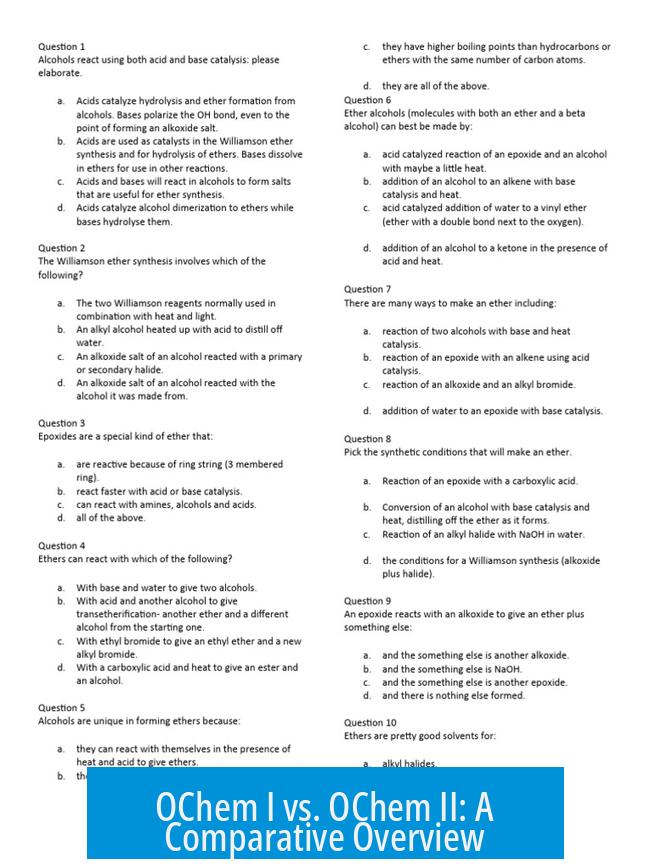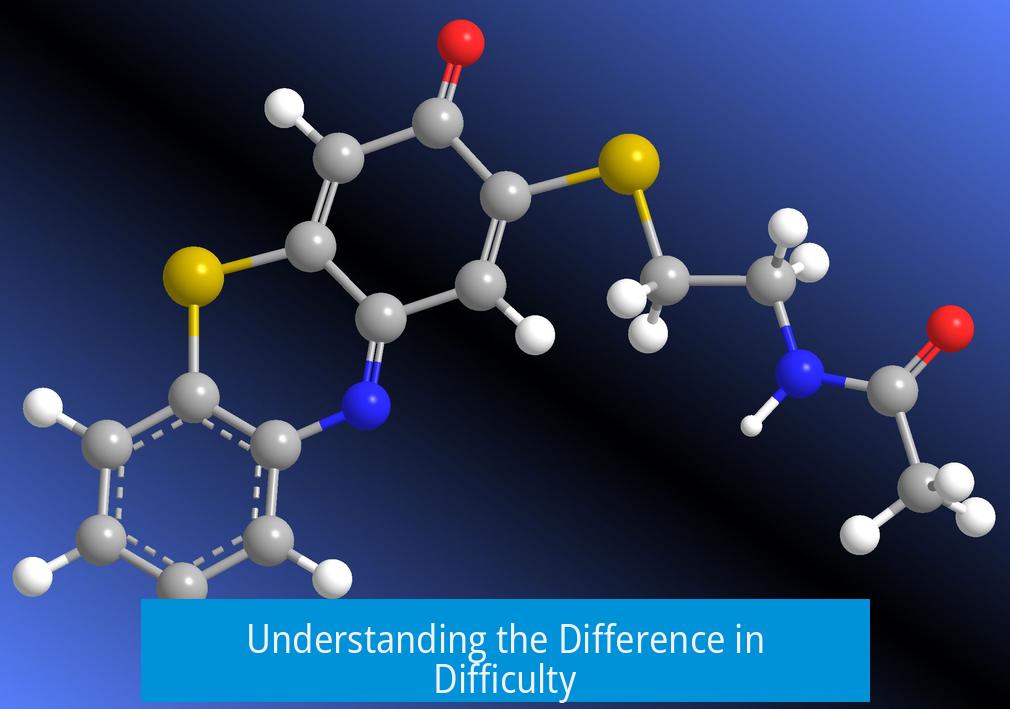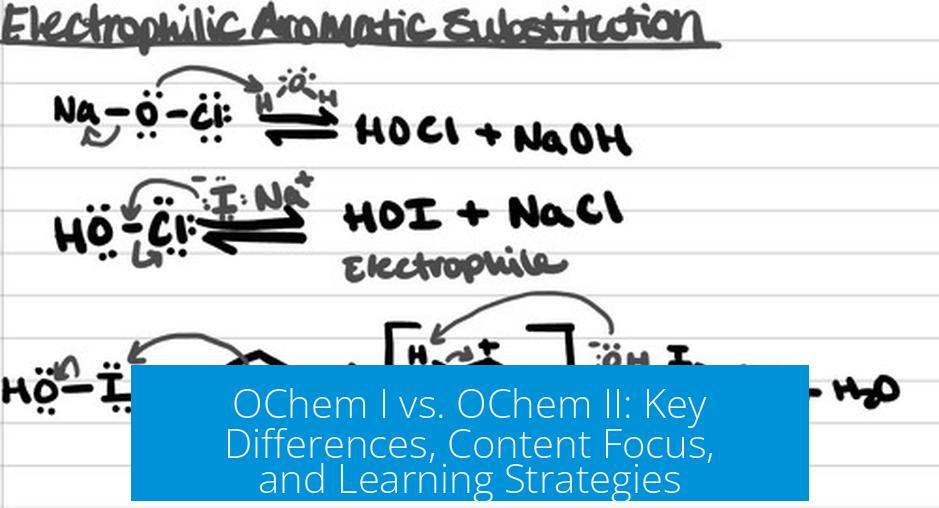OChem I vs. OChem II: A Comparative Overview

Organic Chemistry I (OChem I) focuses on foundational concepts and basic reaction mechanisms, while Organic Chemistry II (OChem II) builds upon that foundation by expanding into intermediate reactions and more complex mechanisms, emphasizing reaction intuition and spectroscopy.
Understanding the Difference in Difficulty

The perceived difficulty between OChem I and II varies among students. Some consider OChem I more challenging due to its heavy emphasis on memorization and foundational language.
- OChem I requires mastering basics like arrow pushing, functional groups, and simple mechanisms.
- OChem II demands greater conceptual understanding and applies knowledge to a broader set of reactions.
Students with a solid grasp in OChem I often find OChem II easier or more engaging, as they can rely on foundational knowledge and focus more on reaction intuition. Conversely, students struggling in OChem I tend to face difficulties in OChem II.
Content Focus in OChem I
OChem I serves to teach the language of organic chemistry. It introduces students to the fundamental principles required to understand organic molecules and their reactivity.
- Language of OChem: Hybridization, chirality, functional groups.
- Basic Mechanisms: Simple reaction types like SN1, SN2, E1, E2.
- Spectroscopy Basics: Introduction to IR and NMR techniques.
- Emphasis on Memorization: Students learn to recall reaction types and procedures effectively.
Students practice arrow pushing and resonance structures, focusing on fundamental reaction pathways. The course typically covers about 10 basic reaction types.
Content Focus in OChem II
OChem II extends the foundational knowledge to include a larger number of intermediate reactions and more detailed mechanistic pathways.
- Expanded Reaction List: Approximately 50 reaction types, covering various functional group transformations.
- Mechanism Intuition: Greater focus on understanding how and why reactions occur.
- Advanced Spectroscopy: Detailed studies in NMR, mass spectrometry, and interpreting spectral data.
- Resonance and Conceptual Depth: Resonance is central in predicting intermediate stability and reaction outcomes.
Students learn to apply the four mechanistic elements rigorously and approach organic chemistry concepts more intuitively, often finding the process engaging once the basics are mastered.
Importance of OChem I Foundation for Success in OChem II
A strong foundation in OChem I directly influences success in OChem II.
- Students with grades below a C in OChem I often struggle in OChem II due to gaps in fundamental knowledge.
- OChem I teaches skills and language critical for understanding OChem II’s mechanisms and reactions.
- Concurrent enrollment in both courses can cause cognitive overload, making it difficult to consolidate knowledge effectively.
Prioritizing OChem I mastery reduces difficulty in OChem II and enhances the overall learning experience.
Learning Strategies for Both OChem I and OChem II
Effective study habits differ in focus but overlap in discipline and consistency.
Tips for OChem I Students
- Read textbook chapters before class to familiarize yourself with terminology and concepts.
- Practice arrow pushing and mechanism problems repeatedly (at least three times) to build speed and confidence.
- Memorize key reaction tables and functional group properties post-lecture.
- Create flashcards for quick review and constant reinforcement.
- Use molecular model kits ($20–30) to visualize 3D structures and stereochemistry.
- Attend office hours regularly with written questions to clarify doubts.
- Utilize tutoring resources for additional guided practice.
Tips for OChem II Students
- Focus on applying knowledge from OChem I rather than rote memorization.
- Prioritize understanding resonance structures and their effects on reaction mechanisms.
- Engage deeply with spectroscopy, interpreting NMR and mass spec data as puzzles to solve.
- Practice predicting product stability and reaction outcomes using mechanistic elements.
Consistent problem-solving plus active engagement with new reactions makes OChem II more intuitive and enjoyable.
Emotional and Psychological Dimensions
Organic chemistry presents both intellectual and emotional challenges.
- OChem I often induces stress due to unfamiliar terminology and demanding memorization.
- OChem II may appear more enjoyable, especially with professors who emphasize reaction reasoning and problem solving.
- Time management and persistence are key, as success hinges on steady effort rather than raw intelligence.
- The courses test tenacity. Students often describe early struggles but note improvements and deeper appreciation as they progress.
Summary Table of OChem I vs OChem II
| Aspect | OChem I | OChem II |
|---|---|---|
| Content | Foundational language, ~10 basic reactions, introductory spectroscopy | ~50 intermediate reactions, advanced spectroscopy, resonance focus |
| Difficulty | Memorization heavy, initial conceptual challenges | Conceptual depth, easier if foundation is strong, more reaction intuition |
| Study Approach | Reading, memorization, repetitive practice | Application, problem solving, active understanding of mechanisms |
| Learning Experience | Language acquisition, basic mechanism practice | Fun and engaging for many, like solving a game or puzzle |
| Emotional Impact | High initial stress, steep learning curve | Rewarding if foundation is solid, demands sustained effort |
Key Takeaways
- OChem I establishes essential language and basic reaction mechanisms necessary for OChem II.
- OChem II builds upon this framework, focusing on broader reaction types and deeper mechanistic understanding.
- Success in OChem II strongly depends on mastering OChem I content thoroughly.
- Both courses require disciplined study, but their methods differ: OChem I relies more on memorization; OChem II rewards conceptual thinking.
- Emotional resilience and time management play critical roles in navigating these courses effectively.





Leave a Comment